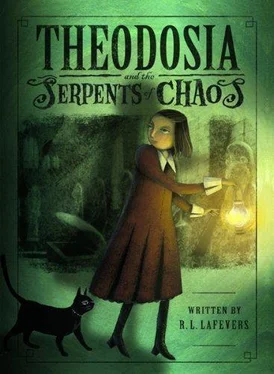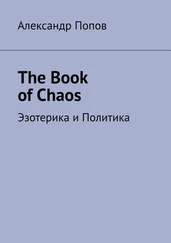R. LaFevers - Theodosia and the Serpents of Chaos
Здесь есть возможность читать онлайн «R. LaFevers - Theodosia and the Serpents of Chaos» весь текст электронной книги совершенно бесплатно (целиком полную версию без сокращений). В некоторых случаях можно слушать аудио, скачать через торрент в формате fb2 и присутствует краткое содержание. Год выпуска: 2007, ISBN: 2007, Издательство: Houghton Mifflin, Жанр: Детские приключения, Детская фантастика, на английском языке. Описание произведения, (предисловие) а так же отзывы посетителей доступны на портале библиотеки ЛибКат.
- Название:Theodosia and the Serpents of Chaos
- Автор:
- Издательство:Houghton Mifflin
- Жанр:
- Год:2007
- ISBN:9780618756384
- Рейтинг книги:5 / 5. Голосов: 1
-
Избранное:Добавить в избранное
- Отзывы:
-
Ваша оценка:
Theodosia and the Serpents of Chaos: краткое содержание, описание и аннотация
Предлагаем к чтению аннотацию, описание, краткое содержание или предисловие (зависит от того, что написал сам автор книги «Theodosia and the Serpents of Chaos»). Если вы не нашли необходимую информацию о книге — напишите в комментариях, мы постараемся отыскать её.
From Booklist Grade 4–8—A combination of Nancy Drew and Indiana Jones, Theo Throckmorton is in big trouble. The 11-year-old lives in London in 1906 and spends most of her time in an antiquities museum headed by her father and filled with objects from her mother’s archaeological expeditions to Egypt. Bossy, clever, and learned in the lore of ancient Egypt, the girl constantly worries that the work-obsessed parents who ignore and neglect her will be destroyed by virulent ancient curses that only she can detect. When her mother returns from her latest trip with an amulet inscribed with curses so powerful they could unleash the Serpents of Chaos and destroy the British Empire, Theo finds herself caught up in a web of intrigue and danger. It pits her, along with some unexpected allies, against German operatives trying to use the scarab as a weapon in their political and economic rivalry with England. Theo must draw on all her resources when she confronts her enemies alone, deep in an Egyptian tomb. There, she makes some surprising discoveries, both personal and archaeological. Vivid descriptions of fog-shrouded London and hot, dusty Cairo enhance the palpable gothic atmosphere, while page-turning action and a plucky, determined heroine add to the book’s appeal. Unfortunately, Theo’s narrative voice lurches between the diction of an Edwardian child and that of a modern teen. The ambiguous ending, with its hints at the approaching World War, seems to promise a sequel. A fine bet for a booktalk to classes studying ancient Egypt.
— Margaret A. Chang, Massachusetts College of Liberal Arts, North Adams
Copyright © Reed Business Information, a division of Reed Elsevier Inc. All rights reserved.
Starred Review “You’d be surprised by how many things come into the museum loaded with curses — bad ones,” says 11-year-old Theodosia, whose parents run London’s Museum of Legends and Antiquities. The twentieth century has just begun, and Theodosia’s mum, an archaeologist, has recently returned from Egypt with crates of artifacts. Only Theodosia can feel the objects’ dark magic, which, after consulting ancient texts, she has learned to remove. Then a sacred amulet disappears, and during her search, Theodosia stumbles into a terrifying battle between international secret societies. Readers won’t look to this thrilling adventure for subtle characterizations (most fit squarely into good and evil camps) or neat end-knots in the sprawling plot’s many threads. It’s the delicious, precise, and atmospheric details (nicely extended in Tanaka’s few, stylized illustrations) that will capture and hold readers, from the contents of Theodosia’s curse-removing kit to descriptions of the museum after hours, when Theodosia sleeps in a sarcophagus to ward off the curses of “disgruntled dead things.” Kids who feel overlooked by their own distracted parents may feel a tug of recognition as Theodosia yearns for attention, and those interested in archaeology will be drawn to the story’s questions about the ownership and responsible treatment of ancient artifacts. A sure bet for Harry Potter fans as well as Joan Aiken’s and Eva Ibbotson’s readers. This imaginative, supernatural mystery will find word-of-mouth popularity.
Gillian Engberg Copyright © American Library Association. All rights reserved











